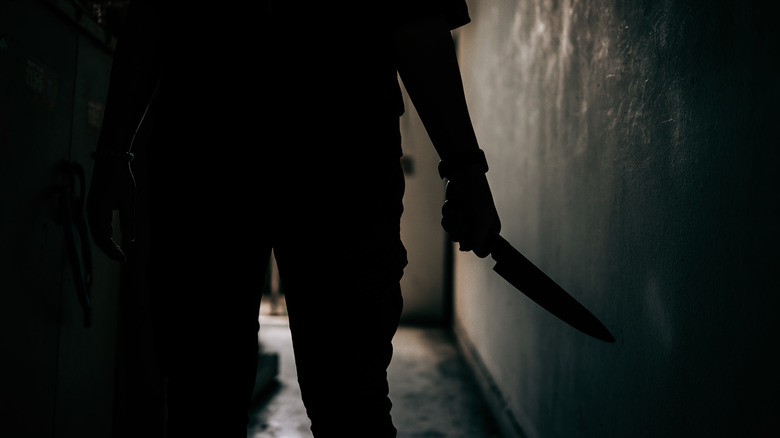The Scariest Movie Of 2023, According To Science
For those of a certain persuasion, few things are as pleasant as a good horror movie. Maybe you're into the slow, creeping dread of an "I'm trapped with a monster" movie like the original "Alien" (yes, it was a horror movie — feel free to debate otherwise). Maybe you like straight-up blood-and-guts body horror. Maybe you dig the paranormal stuff, like "The Conjuring" series, or movies with priests shouting holy incantations at the vomitously possessed. Then again, a film or show need not be horrific simply because it contains knives and gnashing teeth, any more than a film or show that doesn't contain those elements can't be horrifying. To wit: Any reality TV show ever.
With so many different horror flavors, could viewers ever agree on which film is the most frightening? 2017's "Veronica" came close, as NME describes, no matter that it contained loads of derivative elements like an Ouija board and a possessed child. According to the Science of Scare Project described on MoneySuperMarket, however, 2023's scariest movie rankings saw a clear winner rise above the pack and induce the greatest overall fear: "Sinister," starring Ethan Hawke. And before folks say, "Yeah, but didn't that movie come out in 2012?" The rankings did not point to the scariest movie released in 2023 — only the scariest movie that people watched during that year, including older films. According to metrics focused on heart rate, "Sinister" scored a 96 out of a possible 100.
A sinister viewing option
In some ways, it's surprising that 2012's "Sinister" made it to the top of 2023's most fear-inducing film list. It's a slow-burn, unhurried character piece built on subtext and unobvious happenings that the audience must ultimately figure out themselves. Ethan Hawke's very natural, everyday portrayal of true crime author Ellison Oswalt helps a lot, as does the overall premise — a central narrative about family relationships — and a rural Pennsylvania setting. There's a bit of info dumping here and there and a somewhat unoriginal monster figure, but those shortcomings can be forgiven for the movie's tight script and spaces of silence that let the viewer breathe and think.
Those spaces of downtime and normalcy between segments of horror might also account for the Science of Scare Project's metrics, as MoneySuperMarket outlines. As mentioned, the study uses data exclusively derived from heart rate. We've got resting heart rate, movie-watching heart rate, heart rate variance (HRV, or the space between beats), heart rate spike, etc. While it's debatable how accurately such measurements capture the experience of "fear," the study is nonetheless more accurate than anecdotal Q&As with audience members.
There's no discussion anywhere of the study's sample size, the composition of the study's population, or the population's familiarity with horror movies (all critical questions), but we at least know that viewers participated over a few-week period leading up to Halloween. The study also used classics like "The Exorcist," "Nightmare on Elm Street," "The Ring," "The Thing," and yes, "Alien."
Skinamarink tops the recent release list
Looking to horror movies released more recently, 2022's tiny, indie, low-budget Canadian horror film "Skinamarink" placed first on on Science of Scare Project's 2022/2023 list and third overall. The name is based on a nursery rhyme of multiple spellings, like "Skidamarink," and "Skinnamarink." As for whether or not "skinama" was intended to sound like "skin them more," aka, "shear off their skin," is unknown. And after watching "Skinamarink," the viewer will likely still not be able to answer that question — or many others — because it has no clear narrative, minimal dialogue, some big jump scares, and loads of extremely dark, grainy, staticky, prolonged shots that intentionally eclipse much of what the viewer can see. ScreenCraft says that the film made its way to the Science of Scare Project's most frightening film list in no small part thanks to TikTok and Reddit.
But despite such rankings, lots of people might not find "Skinamarink" frightening at all — same goes for "Sinister." After all, "fear" may be a shared, universal human experience, but its causes are diverse, ranging from the most obvious (i.e., "The man has a knife") to the most deeply psychological (i.e., "The movie reminds me of the helplessness felt when watching a loved one succumb to disease). On that note, Psychology Today lists a bunch of horror movie elements that people find frightening: darkness, crawly things on the skin, lightning, "spooky music," and so on. And to be sure, some of those elements make their way into both "Sinister" and "Skinamarink."

